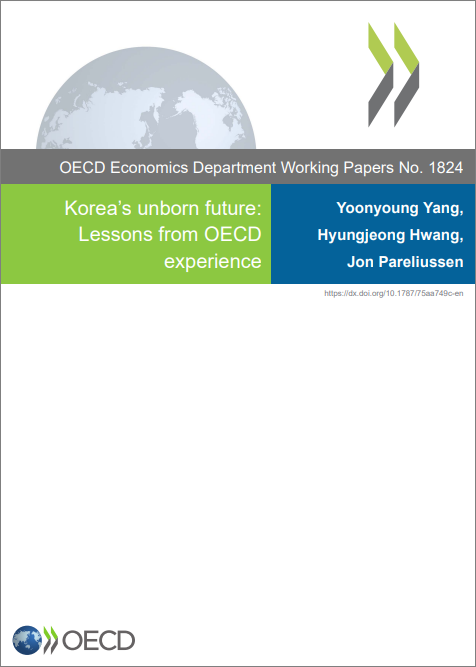
□ 정부는 가족 정책을 강화하고 부모 휴직 및 유아교육을 확대했으나, 노동시장 이중구조, 엄격한 사회적 성 역할 규범, 유연근무제 부족 등으로 인해 여성들이 경력과 육아를 병행하기 어려운 실정임
□ OECD 국가들의 성공 사례는 부모와 가족 친화적인 근무 환경, 균형 잡힌 사회적 규범, 질 높은 육아 지원의 중요성을 보여주며, 한국은 이를 통해 출산율을 개선하고 여성 고용률을 높일 수 있는 잠재력을 가지고 있음
목차
Title page
Contents
Abstract/Résumé 4
1. Introduction and background 7
2. Family policies 14
2.1. Early childhood education and care 16
2.2. Parental leave 26
2.3. Financial transfers 31
3. Working conditions 33
3.1. Work hours and flexible working arrangements 34
3.2. Job stability, job quality and labour market dualism 37
4. Social norms 38
4.1. Changing norms towards marriage and having children 40
4.2. Norms towards women and men as caregivers and breadwinners 43
4.3. Can policies facilitate more fertility-friendly norms? 46
5. Conclusions 50
References 52
Table 1. Societal transitions: stylised features 39
Figure 1. Fertility has fallen over time across the OECD 7
Figure 2. Korea's population will fall dramatically with the current fertility rate 8
Figure 3. Korea's elderly dependency ratio will rise rapidly 8
Figure 4. Female employment has increased over time in most OECD countries 9
Figure 5. The gender employment gap opens up as Korean women enter their 30s 9
Figure 6. Korea's gender wage gap is the highest in the OECD 10
Figure 7. Fertility rates vary considerably across Korea 11
Figure 8. Total fertility rate and gender employment gap 12
Figure 9. Female employment rate of tertiary graduates is lower than the OECD average 13
Figure 10. Family spending varies in size and composition 15
Figure 11. Public early childhood education and care spending has increased significantly in Korea 17
Figure 12. Korea's enrolment rate in early childhood education and care services is high 18
Figure 13. Participation in out-of-school-hours services is high in Korea 19
Figure 14. Net childcare costs are relatively low in Korea 22
Figure 15. Net childcare costs for low-income families are higher than for average earners 22
Figure 16. Korea's child-to-staff ratio is higher than the OECD average 23
Figure 17. Enrolment in public childcare institutions is low in Korea 25
Figure 18. Paid leave entitlements differ across the OECD 27
Figure 19. Parents in Korea are less likely to use their parental leave than in most OECD countries 30
Figure 20. Public expenditure on child-related leaves in Korea is among the lowest in the OECD 31
Figure 21. Public expenditures for cash transfers and tax breaks for families are low in Korea 32
Figure 22. Long working hours are prevalent in Korea 34
Figure 23. Few workers utilise flexible working time arrangements in Korea 37
Figure 24. Norms tie childrearing and marriage closely together 40
Figure 25. Births outside marriage remain extremely uncommon in Korea 41
Figure 26. Marriage may imply giving up some freedoms 42
Figure 27. Exit from marriage may have a considerable social cost 42
Figure 28. Norms towards marriage and childbirth are changing in Korea 43
Figure 29. Korean norms are against working mothers 44
Figure 30. Norms towards working mothers are conservative also among the young 44
Figure 31. Korean men are seen as the main bread-winners 45
Figure 32. Gender gaps in time spent on paid and unpaid work are relatively large in Korea 45
Boxes
Box 1. Out-of-school-hours programmes in selected OECD countries 20
Box 2. OECD recommendations to maintain the quality of ECEC staff 24
Box 3. Estonia's comprehensive, universal and generous parental leave 28
Box 4. Types of family cash benefits 31
Box 5. Lump sum birth grants 33
Box 6. Female representation in the Norwegian parliament (Stortinget) 48
Box 7. Formal speech, Sweden's Du-reform and naming conventions in corporate Korea 49



